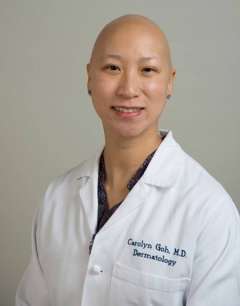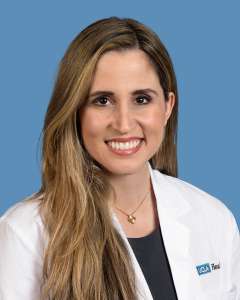Hair and Scalp Disorder Clinic
Find your care
Whether you need ongoing treatment or want to enhance your appearance, we can help.
- Medical dermatology services: 310-825-2631
- Cosmetic services:
310-206-7546 - Hair and scalp consultation:
310-825-6911
At the UCLA Health Hair and Scalp Disorder Clinic, our board-certified dermatologists specialize in diagnosing and treating all types of scalp and hair disorders. We are dedicated to providing expert and personalized care in a safe and caring environment.
What Causes Hair Loss?
Hair loss can happen for many reasons, and it can affect people physically and emotionally. Your genes, hormone levels, stress, certain medications and other medical conditions can all contribute to hair loss. Learning about your medical history can help doctors figure out why you are losing hair and create the best treatment plan for you.
Common causes of hair loss:
- Androgenetic alopecia, often referred to as male or female pattern hair loss, is a hereditary form of hair loss caused by hormonal and other age-related changes. In men, it often appears as a receding hairline and thinning on the crown, while women generally experience thinning throughout the scalp, especially at the middle hair part.
- Alopecia areata is a skin condition where the body's immune system targets its own hair cells. This leads to patchy hair loss, primarily on the scalp. It affects about 2% of the global population and can happen at any age. You may be more likely to get it if someone in your family has it or if you have a personal history of other autoimmune conditions.
- Telogen effluvium is a temporary form of hair loss that happens when hair follicles on the scalp enter the resting (telogen) phase too early. This leads to more shedding than usual and causes the hair to look thinner. Usually, this type of hair loss occurs because of severe stress, infection, surgery, nutritional deficiencies or certain medications. Most people’s hair grows back once the underlying cause is addressed.
Hair Loss Treatment Options
Every person is different. Treatment options at the Hair and Scalp Disorder Clinic include:
Topical medications
What: Liquid solutions, foams or oils applied directly to the scalp. Examples include minoxidil (Rogaine) and topical corticosteroids.
Advantages: Direct application to affected areas; minimal systemic side effects.
Drawbacks: Requires consistent application; may affect hair texture and appearance; results can vary and typically take 6-12 months.
Oral medications
What: Pills taken by mouth. Examples include finasteride (Propecia), spironolactone, minoxidil and immunosuppressive medications.
Advantages: Can treat extensive hair loss; some may experience significant regrowth.
Drawbacks: Potential systemic side effects; not suitable for everyone, especially pregnant women and patients with other medical conditions.
Injections
What: Corticosteroid injections into the scalp
Advantages: Targeted treatment; can show promising results for certain types of hair loss.
Drawbacks: Discomfort during injection; potential side effects like skin thinning.
Laser therapy
What: Low-level lasers used to stimulate hair follicles
Advantages: Non-invasive; can be used in conjunction with other treatments; can be done at home.
Drawbacks: Results vary; cost.
Wigs, hairpieces and camouflage
What: Cosmetic solutions offering immediate appearance benefits.
Advantages: Variety of styles; boosts confidence; immediate solution.
Drawbacks: Needs regular maintenance; potential for displacement; may not feel as natural as one's own hair; cost.
What to Expect at the UCLA Health Hair and Scalp Disorder Clinic
Before your visit
To ensure a thorough and accurate assessment of your scalp and hair, please consider the following before your appointment:
- Remove any camouflage, hairpieces or weaves: Do your best to avoid wearing any hairpieces, weaves or other hair camouflage products before your visit. This will allow our providers to see your natural scalp and hair clearly for an accurate examination and diagnosis.
- Complete our Hair Questionnaire: If you have access to myUCLAhealth, please complete the hair questionnaire ahead of your visit. This will provide us with helpful background information about your hair and scalp health. If you do not have online access, please allow for extra time to complete the questionnaire in the office.
- Bring previous biopsy and lab results: If you’ve had previous biopsies or lab tests related to your hair loss (such as thyroid, vitamin D or iron levels), please bring copies of these results to your appointment. This information may help guide your diagnosis and treatment plan.
- Discontinue biotin-containing supplements: If you are taking biotin supplements, please stop using them for at least one to two days before your visit. Biotin can interfere with certain blood tests. We want to ensure accurate results if any bloodwork is needed.
- Shampoo as usual: It’s perfectly fine to shampoo your hair as you normally would before your visit. We will take the current state of your scalp and hair into account when we do our exam.
- Consider watching our educational video: To help prepare for your visit, you may find it helpful to watch this video by Dr. Carolyn Goh for basic information about hair and hair loss.
Step #1: Consultation
After you arrive, our providers will conduct a thorough consultation to address your concerns about your hair and scalp health. This process often begins with a detailed questionnaire, which is carefully reviewed by your provider. By understanding your medical and family history, we aim to identify potential future hair loss patterns, assess treatment efficacy and uncover underlying causes.
Step #2: Diagnosis
Step #3: Treatment
After diagnosing your hair loss and assessing its severity, your provider will recommend a personalized treatment plan. This plan may include topical treatments, oral medications or more advanced treatments. Our primary goal is to provide the most effective solution for your unique situation. Please note that while we do not offer hair restoration surgery or platelet rich plasma (PRP) injections here; we can refer you to trusted specialists if these treatments are appropriate.
Step #4: Progress tracking
To monitor changes over your visits, we'll take photographs of the affected scalp area. These images will be securely stored in your medical record.
Meet Carolyn Goh, MD

Dr. Carolyn Goh practices medical dermatology with a specialty in hair loss and scalp disorders. She completed undergraduate studies at Stanford University and graduated medical school at Weill Medical College of Cornell University with honors in both research and community service. She completed her residency at New York-Presbyterian Hospital/Cornell in New York City.
Dr. Goh's research and clinical interests are in all types of hair loss, including alopecia areata and scarring alopecia. She uses a personalized patient-centered approach and creates unique treatment plans using evidence-based medicine and shared decision making to attain best results. She is active with patient advocacy groups for patients with hair loss. She is regularly invited to speak at national and international meetings to educate other dermatologists.
Meet Delila Foulad, MD

Dr. Delila Foulad is a medical dermatologist with a special clinical and research interest in hair loss and scalp disorders. She graduated medical school from the David Geffen School of Medicine at UCLA and completed her residency at UC Irvine, where she served as the academic chief resident. She provides patients with an innovative and patient-centric approach to dermatological care, emphasizing patient well-being and advancing research in the field.